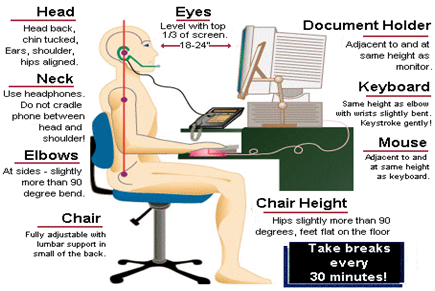The Importance of Good Posture
Humans are bipedal mammals which means our design encourages us to be upright. As technology has evolved and our work demands have drastically changed, this means a majority of our population now works at a desk.
Starting from the top-down, sitting encourages our necks to jut forward, our shoulders to round, our backs to slump, our abs and hip flexors to shorten, and our hip extensors to lengthen.
As our muscles stabilize joints, asymmetrical muscle length and tension imposes asymmetrical stress on those joints. A good analogy for this is the classic childhood game tug-of-war. The two teams during the game are the opposing muscle groups of a joint. If one team is significantly stronger than the other, the flag in the middle is pulled toward the strong side. Similarly, if one muscle group is stronger or tighter than the opposing side, the joint is pulled one direction and subsequently abnormally stressed. This can result in your classic wear-and-tear and eventually pain.
A fascinating study was performed Nachemson et al. in 1976 and supported by Wilks et al. in 1996. In the study, the researchers probed the lumbar intervertebral discs (IVD) with a pressure-detecting needle. The pressure was then measured in a series of different positions. You'll see in the diagram below that standing upright is 100% while the other percentages are relative to that upright position. The big takeaway is that sitting in a slumped position (think of your posture at the end of a long workday) and bending over while holding a weight (doing laundry, emptying the dishwasher, etc.) are the positions that place the highest demand on the low back.
This diagram is not meant to invoke fear of these positions but rather to encourage you as the desk worker and daily lifter to reduce excessive time in these positions and to strengthen appropriately to ensure stability in your joints. (Please see my post "How Much Should I Be Exercising Each Week?" to learn more about how frequently and intensely you should be exercising.)
So how do you know the correct desk position for your body type? I love the ergonomic adjustment tool here which matches desks, chairs, and equipment to your specific body measurements. The picture below can serve as a quick screen to promote a healthy posture for a sitting desk. The same upper body and head rules apply to a standing desk. If you are still having issues at your desk, I strongly recommend seeking help from an ergonomic specialist who can perform an on-site evaluation of your desk setup.
H-J. Wilke, P. Neef, M. Caimi, T. Hoogland and L. E. Claes, Spine 24, #8, pp. 755-762, 1999.
A. L. Nachemson, Spine 1, #1, pp. 59-71, 1976
https://www.thehumansolution.com/ergonomic-office-desk-chair-and-keyboard-height-calculator/


